The Supermicro Hyper SuperServer SYS-112H-TN is a versatile server platform designed to meet the demanding needs of modern enterprise environments. Featuring a single Intel Xeon 6 processor, this 1U system delivers a blend of performance and efficiency within a compact footprint.
With support for an array of storage and I/O options, the server can be tuned for diverse workloads, including virtualization, cloud computing, big data analytics, and AI inferencing applications. The SYS-112H-TN is positioned as a mainstream server solution that stands out for its adaptability rather than being the top performer in any specific category.
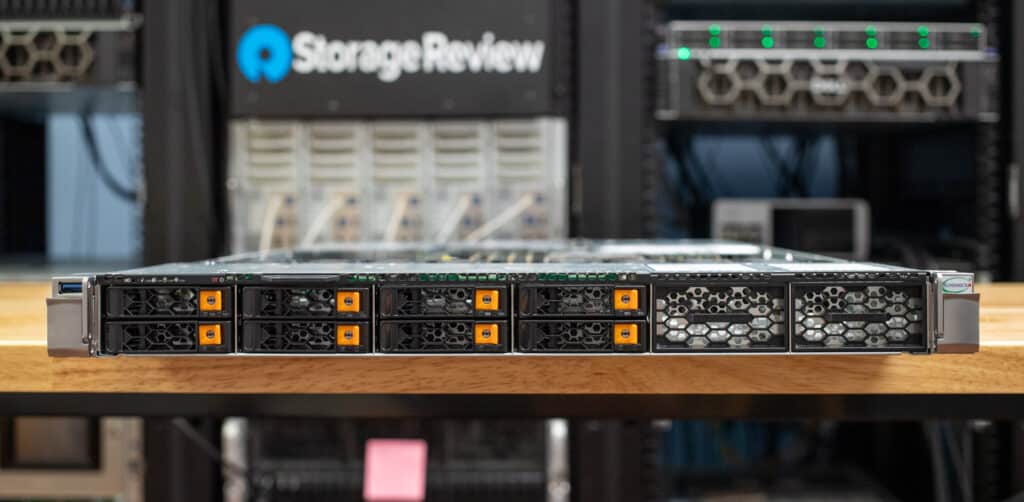
Supermicro SYS-112H-TN Powered By Intel Xeon 6 processors
The main highlight of the SYS-112H-TN is the Intel Xeon 6 processor, marking it as one of the first servers to ship with these latest chips. Xeon 6 processors offer a balance of cores and threads, making them well-suited for mainstream enterprise tasks. With support for up to 16 DIMM slots and up to 1TB of ECC DDR5 memory, the server ensures high-speed data processing and reliability, which is crucial for tasks that require significant data throughput and minimal latency. This memory capacity allows the SYS-112H-TN to handle intensive workloads efficiently.
The introduction of Intel’s Xeon 6 processors, specifically the Sierra Forest 6780E and 6766E, which we tested in an early Intel launch server, offers an exciting addition to the market. These processors are designed with efficiency and scalability in mind, making them ideal for the SYS-112H-TN’s target applications. With a focus on balancing core count and power consumption, the Xeon 6 series enables the SYS-112H-TN to deliver solid performance without excessive energy use. This makes the server an attractive option for businesses looking to optimize their IT infrastructure’s cost-effectiveness.
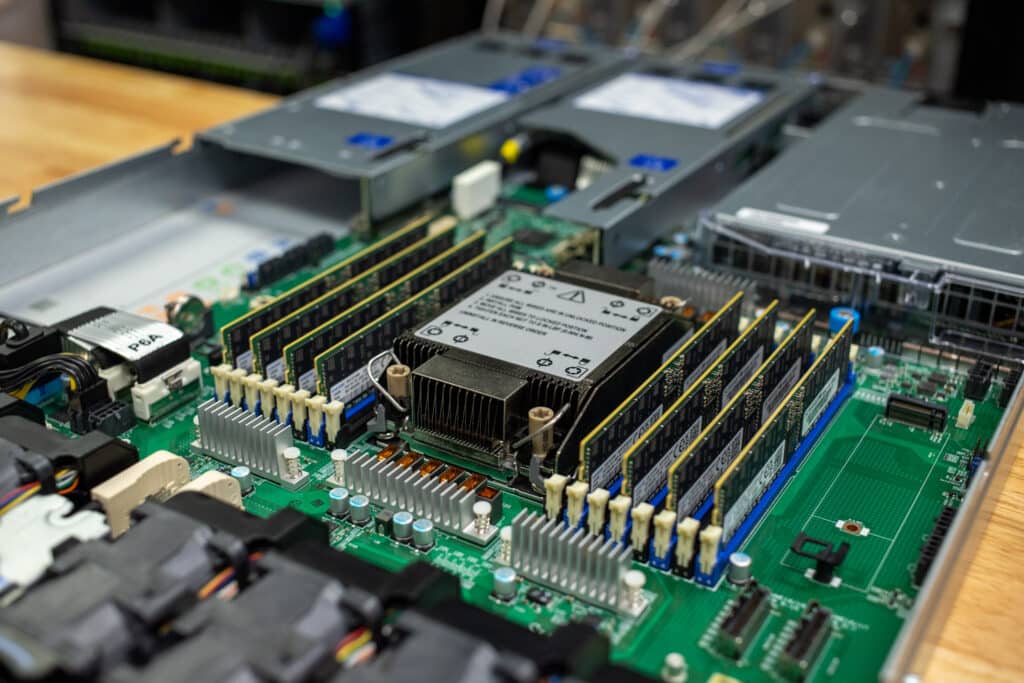
The Xeon 6 processors also substantially improve performance-per-watt, particularly for workloads that benefit from high core counts and efficiency. Businesses with tasks ranging from AI inference and media transcoding to general compute tasks will undoubtedly enjoy this enhancement. For a detailed analysis of these processors, readers can refer to our comprehensive first look at the Intel Xeon 6 series, which covers the performance metrics and real-world applications. In this review, we see how they perform inside a Supermicro server.
Supermicro Hyper 1U SYS-112H-TN Components and Features
The Supermicro Hyper 1U SYS-112H-TN features PCIe Gen5 support, including two PCIe 5.0 x16 slots and an additional PCIe 5.0 AIOM slot. This enables high-speed connectivity for various expansion cards, like GPUs or NICs.
The server also includes up to eight hot-swap 2.5″ drive bays that support NVMe, SAS, and SATA drives. For users needing additional storage, there is an option to expand to twelve bays with four more hot-swap 2.5″ SAS/SATA drive bays. This setup is complemented by dual M.2 NVMe slots on the board.
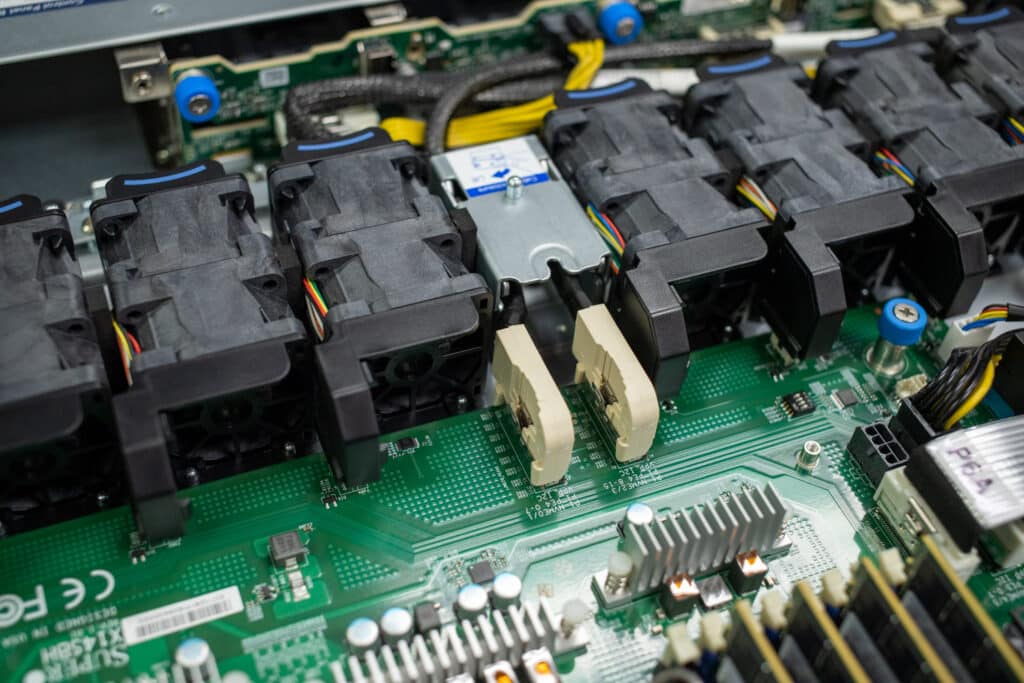
The SYS-112H-TN’s networking capabilities, like the AIOM slot, are compatible with OCP NIC 3.0, offering flexible and high-bandwidth networking configurations suitable for data-intensive applications and virtualized environments. The server also has a dedicated 1GbE LAN port for out-of-band management, ensuring administrative tasks do not interfere with primary data operations. This separation of management and data traffic helps maintain optimal performance and security.
Regarding efficiency and manageability, the SYS-112H-TN is compatible with Supermicro’s comprehensive suite of management tools, including SuperCloud Composer and Supermicro Server Manager. These tools simplify monitoring and managing hardware resources, improving operational efficiency.
The server includes redundant 1200W Titanium-level power supplies, providing high energy efficiency and reliability.
Supermicro Hyper 1U SYS-112H-TN Specifications
| Category | Specification |
| Form Factor | 1U Rackmount |
| Dimensions | Enclosure: 437 x 43 x 778.7 mm (17.2″ x 1.7″ x 30.66″) Package: 672 x 224 x 1100 mm (26.46″ x 8.82″ x 43.31″) |
| Processor | Single Socket E2 (LGA-4710) Intel® Xeon® E-2300 series processors Up to 144C/144T; Up to 108MB Cache |
| GPU | Up to 1 double-width or two single-width GPUs PCIe 5.0 x16 CPU-to-GPU Interconnect |
| System Memory | 16 DIMM slots Up to 1TB 6400MT/s ECC DDR5 RDIMM (1DPC) Up to 1TB 5200MT/s ECC DDR5 RDIMM (2DPC) |
| Drive Bays | Default: 8 front hot-swap 2.5″ NVMe/SAS/SATA bays Option A: 12 bays (8 front hot-swap 2.5″ NVMe/SAS/SATA + 4 front hot-swap 2.5″ SAS/SATA) |
| M.2 Slots | 2 M.2 NVMe slots (M-key 2280/22110/25110; VROC required for RAID) |
| Expansion Slots | 1 PCIe 5.0 x16 FHHL slot 1 PCIe 5.0 x16 FHFL double-width slot 1 PCIe 5.0 x16 AIOM slot (OCP 3.0 compatible) |
| On-Board Devices | NVMe RAID 0/1/5/10 support (Intel® VROC RAID key required) System on Chip (SoC) |
| Networking | AIOM slot (OCP NIC 3.0 compatible) 1 RJ45 1GbE Dedicated BMC LAN port |
| Input / Output | LAN: 1 RJ45 1GbE Dedicated BMC LAN port USB: 2 USB 3.0 ports (rear), 1 USB 3.0 port (front) Video: 1 VGA port |
| Cooling | 8 counter-rotating 40x40x56mm Fans 1 CPU Air Shroud |
| Power Supply | 2x 1200W Redundant (1 + 1) Titanium Level (96%) power supplies |
| System BIOS | AMI 64MB SPI Flash |
| Management | SuperCloud Composer Supermicro Server Manager (SSM) Super Diagnostics Offline (SDO) Supermicro Thin-Agent Service (TAS) SuperServer Automation Assistant (SAA) |
| PC Health Monitoring | CPU: Monitors for CPU Cores, Chipset Voltages, Memory Fans: Tachometer monitoring, status monitor for speed control, Pulse Width Modulated (PWM) fan connectors Temperature: Monitoring for CPU and chassis environment, Thermal Control for fan connectors |
| Weight | Gross Weight: 41.4 lbs (18.8 kg) Net Weight: 19.2 lbs (8.7 kg) |
| Operating Environment | Operating Temperature: 10°C ~ 35°C (50°F ~ 95°F) Non-operating Temperature: -40°C to 70°C (-40°F to 158°F) Operating Relative Humidity: 8% to 90% (non-condensing) Non-operating Relative Humidity: 5% to 95% (non-condensing) |
Supermicro SYS-112H-TN Design and Build
The Supermicro SYS-112H-TN measures 30.66″ in depth, making it a relatively compact Server.
The front houses the eight hot-swappable 2.5″ drive bays and, in our review model, the space where four optional SATA/SAS drive bays can be added for further expansion. The front panel also includes essential controls and indicators, such as power and UID buttons, status LEDs for monitoring system health, and a USB 3.0 port for quick access to external devices.
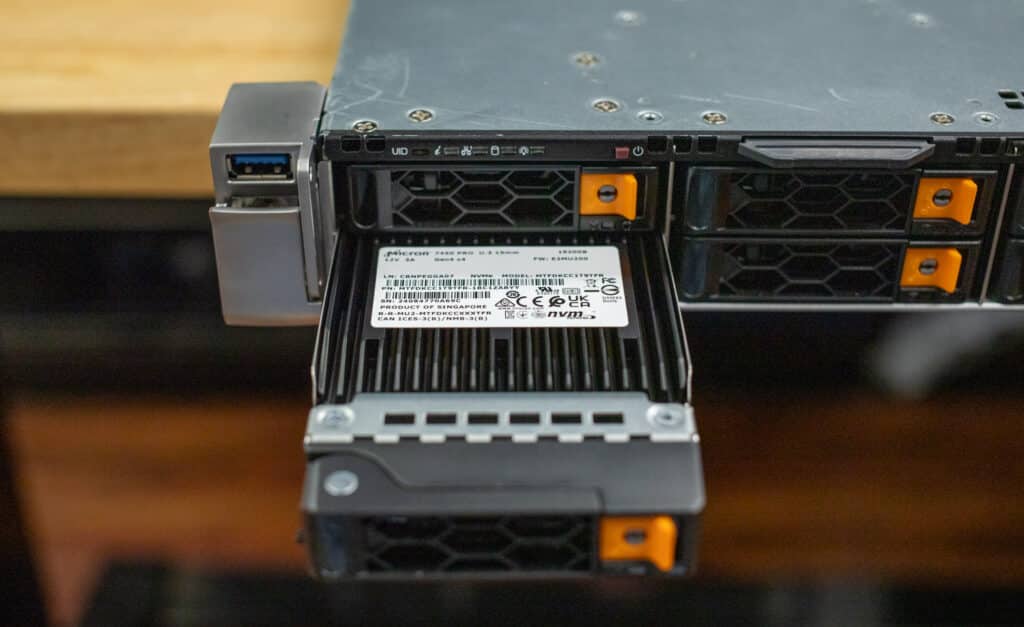
The server’s rear includes two PCIe 5.0 x16 slots for full-height, full-length cards (one is double-wide), and the OCP slot, allowing for high-speed network or storage expansions. The server’s redundant Titanium-level power supplies ensure reliability and uninterrupted operation with options up to 1600W. Additional connectivity for USB and OoB management is also on the back.
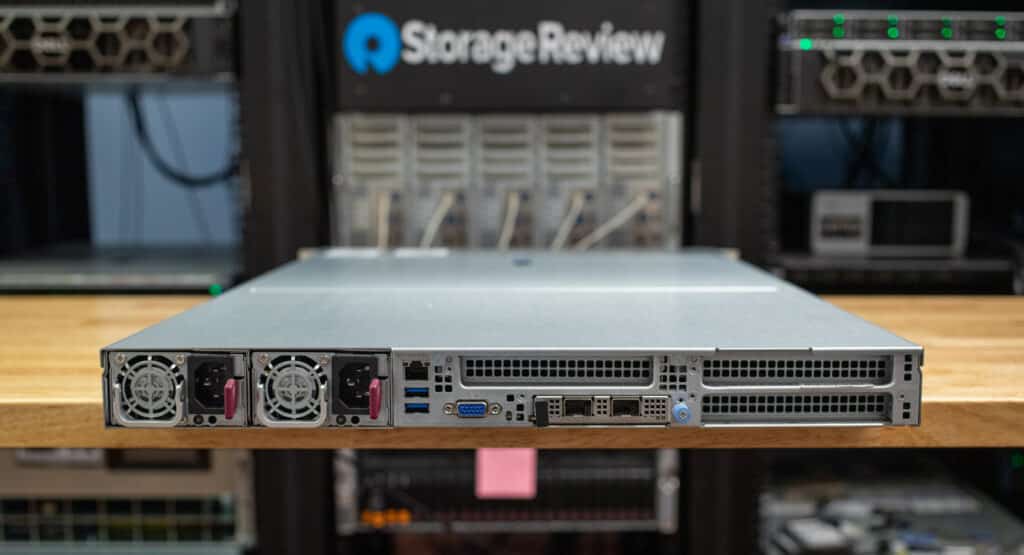
Inside the SYS-112H-TN, the layout is organized to optimize airflow and maintain efficient thermal management. The server has eight internal fans to ensure consistent cooling across all critical components. The single Intel Xeon 6 Scalable processor is centrally located, flanked by 16 DIMM slots that support DDR5 memory. The motherboard also includes two NVMe M.2 slots.
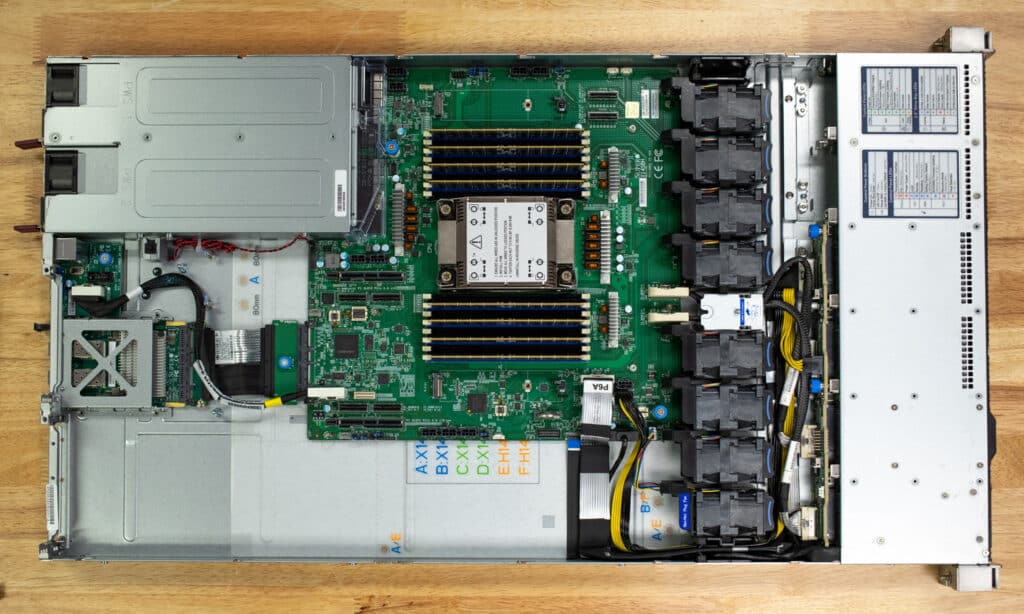
Supermicro Hyper 1U SYS-112H-TN Performance
Our Supermicro Hyper 1U SYS-112H-TN review unit is configured with the following:
- CPU: Intel Xeon 6780E 144-core
- RAM: 512GB DDR5
- SSD: Micron 7450 NVMe Datacenter SSD
- Windows 10 64-bit (10.0.20348)
In our benchmarks, we compare the performance of the Supermicro Hyper 1U SYS-112H-TN with the results from our initial review of Intel’s launch server outfitted with the same Xeon 6 processor family. This comparison is helpful because it examines how these processors perform across different server architectures, allowing us to provide more valuable benchmark results. It can tell us how server design and configuration impact overall performance and efficiency in real-world applications.
Blender OptiX 4.0 / 4.1
Blender is an open-source 3D modeling application. This benchmark was run using the Blender Benchmark utility. The score is samples per minute, with higher being better.
The Supermicro Hyper 1U 112H-TN loaded with a single Xeon 6780E shows solid performance but falls expectedly short compared to the Intel (launch) server with dual Xeon CPUs. For instance, in the “Monster” scene, the Supermicro setup achieves 781.42 samples per minute, whereas the dual Xeon 6780E setup hits 1,410.463 samples per minute. This shows that while the single CPU setup is competent for 3D rendering, the dual CPU configuration nearly doubles the performance, making it better suited for more demanding 3D workloads. The Supermicro would likely outperform the launch Intel server if outfitted with dual CPUs.
| Blender 4.0 CPU | Supermicro Hyper 1U 112H-TN (1x Xeon 6780E, 512GB DDR5) | 2x Xeon 6780E (256GB DDR5) | 2x Xeon 6766E (256GB DDR5) |
| Monster | 781.42 | 1410.463 | 1297.715 |
| Junkshop | 514.658 | 862.418 | 777.716 |
| Classroom | 370.52 | 696.543 | 628.960 |
| Blender 4.1 CPU | |||
| Monster | 764.112 | N/A | N/A |
| Junkshop | 511.872 | N/A | N/A |
| Classroom | 363.672 | N/A | N/A |
Geekbench 6
Geekbench 6 is a cross-platform benchmark that measures overall system performance. The Geekbench Browser allows you to compare any system to it.
The CPU Single-Core score of 1,154 reflects decent single-threaded performance, which is sufficient for tasks that rely on individual core speed. The CPU Multi-Core score of 15,167 highlights the Xeon 6780E’s ability to handle multi-threaded tasks efficiently. This makes the system well-suited for workloads leveraging multiple cores, such as virtualization, database management, and multi-user environments. While these scores are solid, they suggest that the Xeon 6780E in this configuration is more geared toward parallel processing tasks rather than excelling in single-core, latency-sensitive applications.
| Geekbench 6 (Higher is better) |
Supermicro Hyper 1U 112H-TN (Xeon 6780E, 512GB DDR5) |
| CPU Single-Core | 1,154 |
| CPU Multi-Core | 15,167 |
Cinebench R23
The Cinebench R23 benchmark tool evaluates a system’s CPU performance by rendering a complex 3D scene using the Cinema 4D engine. It measures single-core and multi-core performance, providing a comprehensive view of the CPU’s capabilities in handling 3D rendering tasks.
The Supermicro Xeon setup achieved 92,516 points in the multi-core test, higher than the original launch dual Xeon 6780E platform (67,984 pts).
| Cinebench R23 | Supermicro Hyper 1U 112H-TN (Xeon 6780E, 512GB DDR5) | 2x Xeon 6780E (256GB DDR5) | 2x Xeon 6766E (256GB DDR5) |
| CPU Multi Core | 92,516 | 67,984 pts | 64,326 pts |
| CPU Single Core | 888 pts | 873 pts | 793 pts |
| MP Ratio | 104.20 x | 77.91 x | 81.10 x |
Cinebench 2024
Cinebench 2024 extends R23’s benchmark capabilities by adding GPU performance evaluation. It continues to test CPU performance but also includes tests that measure the GPU’s ability to handle rendering tasks.
The Supermicro Hyper 112H-TN scores 2,941 pts in multi-core, outperforming the dual Xeon 6780E setup, which scored 2,687 pts. This is another instance where the single CPU setup shows robust optimization in the Supermicro server, delivering superior performance in specific multi-threaded applications.
| Cinebench R23 | Supermicro Hyper 1U 112H-TN (Xeon 6780E, 512GB DDR5) | 2x Xeon 6780E (256GB DDR5) |
2x Xeon 6766E (256GB DDR5) |
| CPU Multi Core | 2,565 pts | 2,687 pts | 2,347 pts |
| CPU Single Core | 53 pts | 43 pts | 45 pts |
| MP Ratio | 48.38 x | 62.85 x | 52.65 x |
Y-Cruncher
Y-cruncher is a popular benchmarking and stress-testing application that launched back in 2009. This test is multi-threaded and scalable, computing Pi and other constants up to the trillions of digits. Faster is better in this test.
In this test, the Supermicro setup was slower, particularly in larger calculations, compared to the Intel launch server with dual CPUs. For example, calculating Pi to 50 billion digits takes 680.090 seconds on the Supermicro setup, whereas the dual Xeon 6780E setup completes it in 565.913 seconds.
| Y-Cruncher (0.8.3.9) (lower is better) | Supermicro Hyper 1U 112H-TN (Xeon 6780E, 512GB DDR5) | Xeon 6780E (256GB DDR5) |
Xeon 6766E (256GB DDR5) |
| 1 Billion | 9.754 seconds | 6.927 seconds | 7.254 seconds |
| 2.5 Billion | 25.215 seconds | 17.898 seconds | 19.507 seconds |
| 5 Billion | 55.242 seconds | 38.454 seconds | 41.116 seconds |
| 10 Billion | 118.657 seconds | 81.146 seconds | 87.403 seconds |
| 25 Billion | 315.085 seconds | 217.530 seconds | 238.813 seconds |
| 50 Billion | 680.090 seconds | 565.913 seconds | 502.245 seconds |
Here are the results from version 0.8.5.9:
| Y-Cruncher (0.8.5.9) (lower is better) | Supermicro Hyper 1U 112H-TN (Xeon 6780E, 512GB DDR5) |
| 1 Billion | 8.757 seconds |
| 2.5 Billion | 24.928 seconds |
| 5 Billion | 53.489 seconds |
| 10 Billion | 113.727 seconds |
| 25 Billion | 308.218 seconds |
| 50 Billion | 674.299 seconds |
Blackmagic Disk Speed Test
In Blackmagic’s disk speed test, the Micron 7450 NVMe SSD produced 3,627.4MB/a read and 2,849.5 MB/s write speeds.
Blackmagic RAW Speed Test
The Blackmagic RAW Speed Test is a performance benchmarking tool designed to measure a system’s capabilities in handling video playback and editing using the Blackmagic RAW codec. It evaluates how well a system can decode and play back high-resolution video files, providing frame rates for both CPU- and GPU-based processing.
The Supermicro Hyper 112H-TN scored 116 FPS in 8K CPU. We did not perform the GPU portion of this test.
7-Zip
The popular 7-Zip utility’s built-in memory benchmark measures the performance of a system’s CPU and memory during compression and decompression tasks, providing an indication of how well the system can handle data-intensive operations.
Here, the Supermicro Hyper 112h-tn achieves a total rating of 205.449 GIPS, notably lower than the 271.217 GIPS achieved by the dual Xeon 6780E setup.
| 7-Zip Compression | Supermicro Hyper 1U 112H-TN (Xeon 6780E, 512GB DDR5) | Xeon 6780E (256GB DDR5) | Xeon 6766E (256GB DDR5) |
| Compressing | |||
| Current CPU Usage | 5287% | 5,891% | 4,768% |
| Current Rating/Usage | 4.647 GIPS | 4.985 GIPS | 4.614 GIPS |
| Current Rating | 245.699 GIPS | 293.689 GIPS | 220.001 GIPS |
| Resulting CPU Usage | 5296% | 5,603% | 5,103% |
| Resulting Rating/Usage | 4.642 GIPS | 4.954 GIPS | 4.638 GIPS |
| Resulting Rating | 245.823 GIPS | 277.670 GIPS | 236.910 GIPS |
| Decompressing | |||
| Current CPU Usage | 6236% | 5,962% | 5,798% |
| Current Rating/Usage | 4.261 GIPS | 4.550 GIPS | 4.152 GIPS |
| Current Rating | 265.709 GIPS | 271.266 GIPS | 240.693 GIPS |
| Resulting CPU Usage | 6236% | 5,832% | 6,029% |
| Resulting Rating/Usage | 4.341 GIPS | 4.540 GIPS | 4.161 GIPS |
| Resulting Rating | 269.373 GIPS | 264.764 GIPS | 250.853 GIPS |
| Total Rating | |||
| Total CPU Usage | 5751% | 5,717% | 5,566% |
| Total Rating/Usage | 4.491 GIPS | 4.747 GIPS | 4.399 GIPS |
| Total Rating | 257.598 GIPS | 271.217 GIPS | 243.882 GIPS |
UL Procyon AI Inference
UL Procyon AI Inference is designed to gauge a workstation’s performance in professional applications. It should be noted that this test does not take advantage of multiple CPU capabilities. Specifically, this tool benchmarks the workstation’s ability to handle AI-driven tasks and workflows, providing a detailed assessment of its efficiency and speed in processing complex AI algorithms and applications.
Results for the Supermicro Hyper 112h-tn (Xeon 6780E, 512GB DDR5) provide insights into the system’s ability to handle various AI-driven tasks. Based on the table below, it’s clear that the server can process simpler models like MobileNet V3 and ResNet 50 efficiently, with inference times of 5.23 ms and 6.60 ms, respectively. However, as the complexity of the models increases, such as with Real-ESRGAN, the inference time rises significantly to 966.48 ms. The overall score of 168 indicates that the Xeon 6780E is capable but may be better suited for moderate AI workloads and would benefit from a dual-CPU configuration.
| UL Procyon Average Inference Times (Lower is better) | Supermicro Hyper 1U 112H-TN (Xeon 6780E, 512GB DDR5) |
| MobileNet V3 | 5.23 ms |
| ResNet 50 | 6.60 ms |
| Inception V4 | 23.12 ms |
| DeepLab V3 | 24.61 ms |
| YOLO V3 | 35.66 ms |
| Real-ESRGAN | 966.48 ms |
| Overall Score | 168 |
Conclusion
Powered by the Intel Xeon 6 series, the Supermicro Hyper SuperServer SYS-112H-TN offers a compelling combination of performance and efficiency, making it a strong contender for various mainstream enterprise applications. Its equipped 6780E processor allows it to excel in multi-threaded workloads, providing robust performance while maintaining energy efficiency. The efficiency gains are particularly impressive when compared to older systems these are likely to replace.
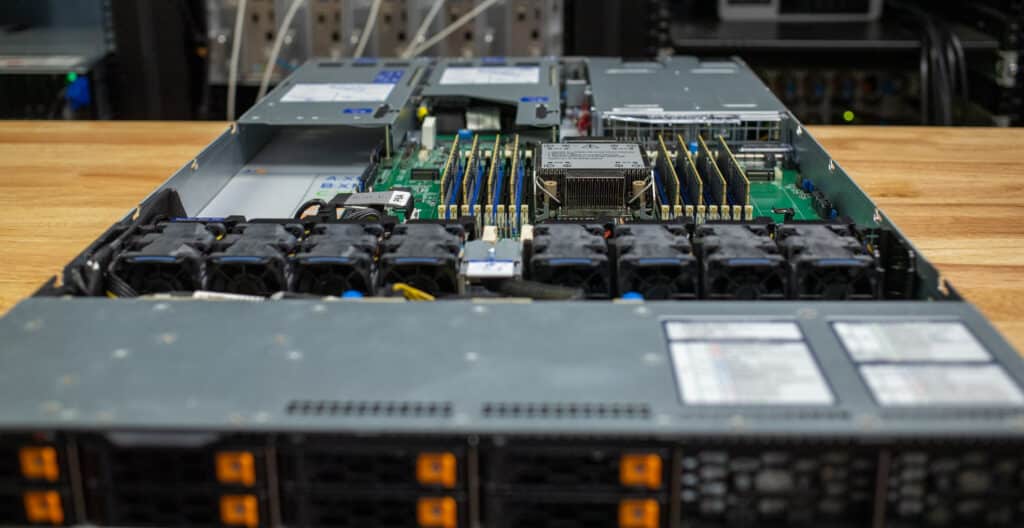
Beyond the capabilities of the Xeon 6 CPUs, the Supermicro Hyper 1U SYS-112H-TN is equipped with a range of features that enhance its versatility and performance. It has two PCIe 5.0 x16 slots and an additional PCIe 5.0 AIOM slot, enabling high-speed connectivity for GPUs, network interfaces, and other expansion cards.
Xeon 6 delivers up to 144 efficiency cores in the Supermicro Hyper 1U SYS-112H-TN, which is excellent for workloads that don’t need the highest-powered silicon. It should be a flexible building block for system integrators and enterprises that want an affordable, yet modern server, for a wide variety of tasks.




 Amazon
Amazon